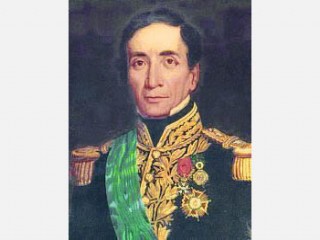
Andres De Santa Cruz biography
Date of birth : 1792-12-05
Date of death : 1865-09-25
Birthplace : La Paz, Bolivia
Nationality : Bolivian
Category : Politics
Last modified : 2010-12-02
Credited as : politician and military leader, former President of Peru and Bolivia,
The Bolivian military leader Andres de Santa Cruz was a supporter of a united Peru-Bolivia and was president of a short-lived confederation of the two.
Andres de Santa Cruz was born on Dec. 5, 1792, in La Paz, the mestizo son of a Peruvian Creole and a Bolivian Indian heiress. After receiving a Church-directed education in La Paz and Cuzco, he elected to follow his father's army career. He was commissioned in a militia unit in 1809 and began active duty a year later, with the onset of the Wars of Independence. His royalist service
lasted until early 1821 and included military action in Bolivia (then Upper Peru) and Peru, as well as an interval as a prisoner of war in Argentina. In January 1821, when once again a captive, he volunteered for the patriot army and served the cause of liberation through the remaining 3 years of fighting.
Santa Cruz commanded units under both Jose de San Martin and Simon Bolivar, became chief of staff for the Peruvian units under the latter, and then was given a series of administrative assignments, first military and then, with the end of fighting, civilian ones.
In July 1825 Santa Cruz became prefect of Chuquisaca (now Sucre), the capital of the newly created Bolivia. He had opposed this Bolivar-designed transformation of Upper Peru, favoring a continued union with Peru. He nevertheless accepted a series of assignments, both in Bolivia and in Peru, given him by Bolivar. Santa Cruz was, in fact, serving in Lima as president of the Peruvian Council of State when, in September 1826, Bolivar left Peru to return to Colombia. In June 1827 Santa Cruz surrendered that office to an elected successor but, after a brief period in Chile, became the chief executive of Bolivia in early 1829. Until 1835 he gave his full attention to governing that country. Under his stern authority, order was restored and some economic gains were achieved.
Meanwhile, Peru was nearly torn apart by the rivalries of political and military factions. In 1835 Santa Cruz was invited to intervene and, with the help of Peruvian allies, established the Confederation of Peru and Bolivia. The new nation was to have three states, each with a large measure of autonomy but with overall control exercised by Santa Cruz, now named to the office of supreme protector.
The union was maintained, although shakily, until early 1839, when it was brought to an end by the united efforts of Argentina, Chile, and its Peruvian opponents. Santa Cruz, forced out of both Peru and Bolivia, spent the next 6 years, mostly in Ecuador, plotting a return to power. In 1845, when it was clear that Chile and the other nations would not allow this, he left for Europe, where he remained for the rest of his life.
There is no biography of Santa Cruz in English, although his career is partially discussed in several general histories of Peru and Bolivia, most notably Frederick B. Pike, The Modern History of Peru (1967), and Robert Barton, A Short History of the Republic of Bolivia (1968). For an understanding of Chile's opposition to the confederation see Robert N. Burr, By Reason or Force: Chile and the Balancing of Power in South America, 1830-1905 (1965). See also Charles W. Arnade, The Emergence of the Republic of Bolivia (1957).
















